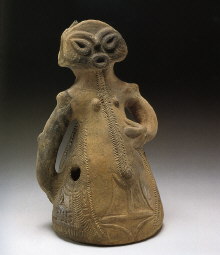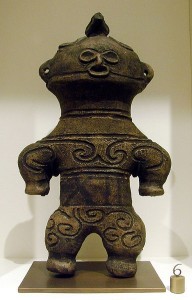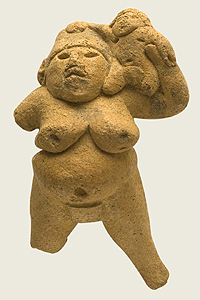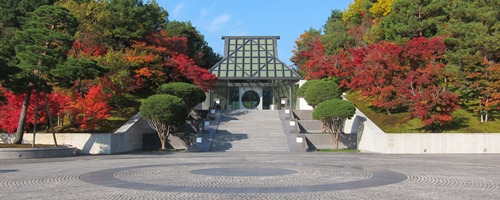Miho Museum near Lake Biwa is holding a special exhibition of ancient clay figurines known as Dogu, dating from literally thousands of years ago. They’re weird and fascinating, possibly early fertility figures. The maple colours at this time of year, together with I.M. Pei’s stunning architecture, mean that the museum is worth a visit in its own right anyway: the exhibition is a plus.
The museum is run by people from the little known Shinji Shumeikai sect, who grow organic vegetables, practice a form of healing, and follow an aesthetic form of spirituality as conceived by their founder, Mihoko Koyama (1910-2003). Part of her philosophy was that exposure to works of beauty helps better one’s character and well-being. (They’ve got a British operation, and I was able to visit their small organic farm near Avebury this summer, together with video-maker Robert MacNaughton who is working on a documentary about Japan’s Creation Myth.)
*******************************************************.
Autumn Special Exhibition: Saturday, September 1 to Sunday, December 9
” Dogū, a Cosmos of Ancient Clay Figurines ” (North Wing)
Where did the strange forms of dogū,or the day figurines from Japan’s prehistoric Jōmon period (14,000 BCE-300 BCE), come from? Some have three fingers, raised arms, amazing physiques, strange expressions, traces of red pigment, or no face. Who or what were they?
If we today could travel in time and meet the people of Jōmon period, we would likely be amazed by their great skill and energy. Making even one Jōmon (cord-patterned) earthenware was not merely a matter of kneading and firing clay. First, the clay had to be found, tempered with sand or other materials, wedged, decorated with amazing patterns, dried, and finally fired.
In addition, these were not fired in kilns but out in the field so the larger the piece, the more ingenurity was required to maintain uniform overall temperature. Such earthenware pieces are rarely found in large quantities.
The Jōmon people also made lacquerware. These objects included sake bottles and cups, earrings, bracelets, and combs that skillfully incorporated red and black lacquer, and beautiful accessories made of decorative beads strung together with red-lacquered string. The upper echelons of Jōmon society were quite fashionable, indeed!
Dogū figurines played a major role in Jōmon festivals. This autumn, many important examples of dogū from all over Japan, including National Treasure-designated Jōmon Venus and the earliest dogū found in Shiga Prefecture, will be assembled at Miho Museum. Please look forward to discovering who they were.
****************************************************************************
Miho Museum, (0748) 82-3411, 300 Momodani, Shigaraki-cho, Koka-shi, Shiga-ken; 10 a.m.-5 p.m. ¥1,000. Closed Mon.
It’s a 20-min. taxi ride from Shigaraki Station, (Shigaraki Kogen Railway Line). It takes about 80 mins from Kyoto, and there are details about how to get there on this website.
There’s a good article about the museum, its philosophy and the Shumei sect at this website.





Leave a Reply